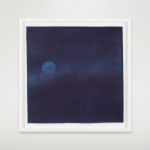Miya Ando b. 1973
Shingetsu (New Moon) May 30 2022, 2022
Natural indigo, graphite, kozo paper
39 x 39 in
99 x 99 cm
99 x 99 cm
8638
Further images
-
(View a larger image of thumbnail 1
)

-
(View a larger image of thumbnail 2
)

-
(View a larger image of thumbnail 3
)

-
(View a larger image of thumbnail 4
)

-
(View a larger image of thumbnail 5
)

-
(View a larger image of thumbnail 6
)

-
(View a larger image of thumbnail 7
)

-
(View a larger image of thumbnail 8
)

This painting by Miya Ando depicts the ephemeral phenomena of the appearance of a new moon, where a faint, silvery edge casts a ghostly glow over the rest of the...
This painting by Miya Ando depicts the ephemeral phenomena of the appearance of a new moon, where a faint, silvery edge casts a ghostly glow over the rest of the moon’s barely visible circular form. The title of the work includes the date when Ando witnessed the phenomena this painting depicts. The painting is made by exposing mulberry paper to natural indigo dye. The presence of light is indicated by the absence of the dye since the longer indigo makes contact with the surface of the paper, the darker blue the surface becomes. As Ando notes, “Indigo is like a little clock of coloration.” The painting belongs to a series of works Ando debuted in her solo exhibition Kumoji (Cloud Path / A Road Traversed By Birds And The Moon) at Kavi Gupta gallery in Chicago. The series addresses the interplay of presence and absence by depicting ephemeral phenomena such as stars, rain, clouds, and the phases of the moon. A practicing Buddhist, Ando works a lot with natural phenomena to express the idea of impermanence. The ephemeral qualities of stars, rain, clouds, and the phases of the moon illustrate the sentiment behind the Japanese phrase “mono no aware,” roughly translated as “the pathos of things.” Beauty fades; strength dissolves into frailty. Everything follows this rule; it is the vernacular of nature. “Something becomes more beautiful and sublime the more impermanent it is,” Ando says. The phases of the moon have the dual quality of being ephemeral, and also reliably recurring, thus demonstrating the cyclical essence of natural processes. The title of this piece is presented in both Japanese and English, a gesture used by Ando to reflect upon the gaps between her dual cultural influences, which are often clearly evident in language. Ando researches Japanese phrases that reference natural phenomena with a poetic and nuanced specificity, and does her best to first translate them into an English equivalent, and then to translate them into a work of visual art.







